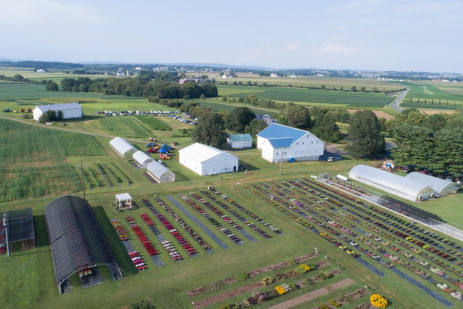Sep 28, 2020Small-scale field grown and season extension budgets offered
Enterprise budgets have been made available by Penn State University for several popular vegetable crops grown in the field and in high tunnels.
Field-grown
Many horticultural crops lend themselves well to small-scale production. These crops can yield substantial income and profits from one acre of production. They may require many hours of labor especially during planting and harvest. Much of the land preparation tasks can be completed using local custom operators reducing the need for expensive equipment. Ask a local farmer if there are any local custom operators available. It will take at least a 75 hp tractor to pull a 5-foot bed shaper and plastic mulch layer but the custom operator can probably accommodate that requirement. After planting, pesticide applications can be completed with various equipment options such as, four-wheelers or with backpack sprayers if larger equipment is not available.
The income for the attached budgets is calculated using recent produce auction prices. By using more direct marketing opportunities, you may be able to increase your potential income but your percentage of sales for marketing may be higher. This figure depends on how much it will cost you to operate and staff a market stand versus the cost of selling at an auction. Remember, it is critical to determine who you will be selling your product to and how much it will cost you to reach the customer using that method of sales. Please develop your markets before beginning production.
Most of the budgets are calculated using plastic mulch to control weeds and reduce stress on the plants but this will require the use of irrigation through a drip tape system installed before planting or while laying the plastic mulch. The irrigation system should be equipped with a fertilizer and pesticide injection system to accommodate the addition of these to the root system of the plants. For field grown crops, you will need to calculate the cost of the line from the water source to main header line at each field.
There are budgets for strawberry production using a matted row production system. This will require the use of straw matting as a mulch to overwinter the plants. This matted row production also incorporates the use of irrigation as frost protection in the spring and incase of reduced rain during the growing season. For more information on drip irrigation systems, please see the link below.
The budgets for field grown crops are:
- Onion Field-grown Budget
- Pepper Field-grown Budget
- Matted-row Strawberry Planting Budget
- Matted-row Strawberry Production Budget
- Strawberry Planting Budget using Plasticulture
- Strawberry Production using Plasticulture
- Red-type Tomato Field-grown Budget
- Winter Squash Field-grown Budget
Season Extension
Many producers try to capture potentially higher early and late season market prices using high tunnels to plant and harvest for these seasons. Growing in high tunnels will require more management skills than producing on open ground due to the high concentration of plants in a small area and the potential for increased insect and disease pressure. By growing in a high tunnel, you will control the amount of water applied but you will need to learn the nuances of ventilation to increase air flow to help reduce disease pressure. Working with an extension educator will help with the learning curve of moving to season extension production.
The plastic film used to cover the high tunnel may need to be replaced about every three years which is included in the budget for the high tunnel cost along with the depreciation for the structure. The depreciation of the tunnel is calculated over ten years so the plastic will need to be replaced three times and is included under the fixed costs section within the tunnel budgets.
The three crops included in the season extension portion are some of the most popular crops produced in high tunnels. These crops are cucumbers, peppers, and tomatoes. The budgets include two methods of insect and disease management systems. One system uses a bio-control method which uses “softer”, more environmentally friendly, products to achieve control. This method may require you to seek the advice of a more experienced producer or an extension educator. The other method is an organic production system using products on the OMRI approved list of products.
Cucumbers
The cucumbers are grown in pots and potting soil with a “spider” irrigation system that has one spider attachment to the drip line and irrigates two pots. The soil in the tunnel is covered with shade cloth instead of raised beds which does increase costs but has no chance of weed growth. The potting soil may be used three times with the pots being “topped off’ after the plants are removed which reduces the long-term costs. The plants will grow on strings attached to the purlins of the high tunnel and will need to be pruned throughout the production season.
Peppers and Tomatoes
The peppers and tomatoes are grown in the soil of the high tunnel using a plasticulture system and stakes and twine to support the growing plants. You should conduct soil health tests at regular intervals to determine the soil health within your tunnel. Removing the plastic the fall prior to replacing with new will allow natural rain and sunlight reduce the build-up of salts in the soil.
The crop budgets for high tunnels include:
- High Tunnel Cucumber Budget
- High Tunnel Organic Cucumber Budget
- High Tunnel Pepper Budget
- High Tunnel Organic Pepper Budget
- High Tunnel Tomato Budget
- High Tunnel Organic Tomato Budget
For More Information
Websites
- Budgeting for Agricultural Decision Making
- Cucumber Production
- Drip Irrigation for Vegetable Production
- Onion Production
- Organic Vegetable Production
- Pepper Production
- Strawberry Production
- Tomato Production
- Extending the Garden Season with High Tunnels
- Penn State Center for Plasticulture
– Lynn Kime, Thomas Ford, Krystal Snyder and Linda Falcone, Penn State University















